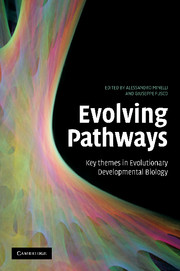Book contents
- Frontmatter
- Contents
- Contributors
- Preface
- Introduction: Pathways of change
- Part I Thinking about evolution by taking development on board
- 1 Evo-devo as a discipline
- 2 Making evolutionary predictions about the structure of development and morphology: beyond the neo-Darwinian and constraints paradigms
- 3 Conflicting hypotheses on the nature of mega-evolution
- 4 Prospects of evo-devo for linking pattern and process in the evolution of morphospace
- 5 The molecular biology underlying developmental evolution
- 6 Evo-devo's identity: from model organisms to developmental types
- Part II Evo-devo: methods and materials
- Part III Evolving diversity
- Part IV Evolving body features
- Index
- References
2 - Making evolutionary predictions about the structure of development and morphology: beyond the neo-Darwinian and constraints paradigms
Published online by Cambridge University Press: 08 August 2009
- Frontmatter
- Contents
- Contributors
- Preface
- Introduction: Pathways of change
- Part I Thinking about evolution by taking development on board
- 1 Evo-devo as a discipline
- 2 Making evolutionary predictions about the structure of development and morphology: beyond the neo-Darwinian and constraints paradigms
- 3 Conflicting hypotheses on the nature of mega-evolution
- 4 Prospects of evo-devo for linking pattern and process in the evolution of morphospace
- 5 The molecular biology underlying developmental evolution
- 6 Evo-devo's identity: from model organisms to developmental types
- Part II Evo-devo: methods and materials
- Part III Evolving diversity
- Part IV Evolving body features
- Index
- References
Summary
According to Darwinism, evolution occurs because, in populations, there is heritable phenotypic variation, and then ecological factors differentially affect the contribution of each of those variants to the next generation. Thus, to understand the way in which phenotypes in a population change over generations (this is the direction of evolutionary change) two questions need to be addressed: (1) which phenotypic variants arise in each generation, and (2) which of these variants are filtered out by ecological factors in each generation. In each generation, and assuming no dramatic genomic rearrangements, developmental dynamics determine which morphological variation arises from genetic and environmental variation. Developmental dynamics are currently not very well understood and thus the question of which phenotypic variants arise in each generation is not well understood either. A different emphasis is given to each of these two questions by different approaches or schools of thought in evolutionary biology.
For many evolutionary biologists, especially those close to the core of neo-Darwinism, this lack of understanding about development has not always been perceived as a limit on progress in understanding morphological evolution (Haldane 1932, Mayr 1982). For some authors (Haldane 1932) this does not derive from lack of understanding development. Instead, natural selection is seen as the main or unique force determining how the phenotype changes (Fisher 1930, Charlesworth et al. 1982). The question of which phenotypic variation arises and what its role is in determining how phenotypic distributions change over time is either not addressed or assumed to be unanswerable.
- Type
- Chapter
- Information
- Evolving PathwaysKey Themes in Evolutionary Developmental Biology, pp. 31 - 49Publisher: Cambridge University PressPrint publication year: 2008
References
- 4
- Cited by



